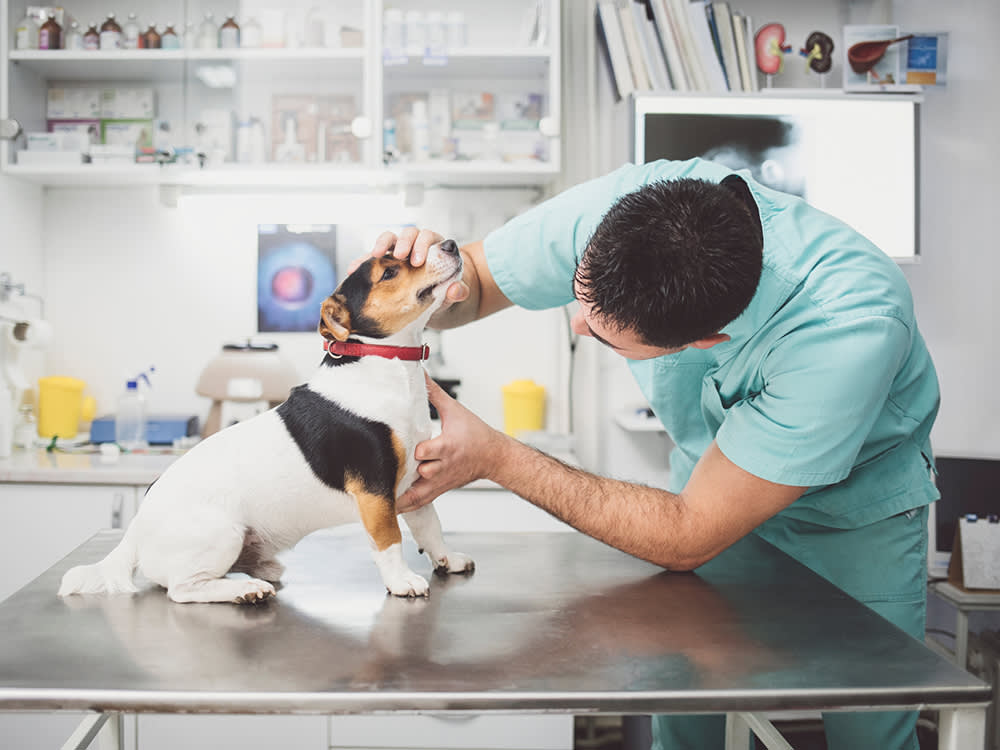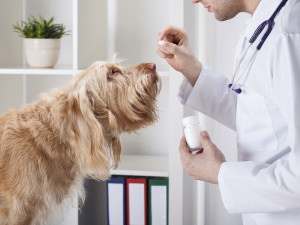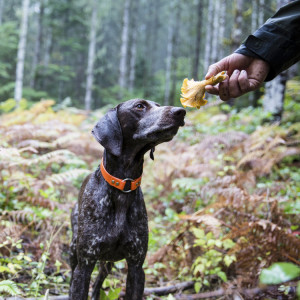Lymphoma Cancer in Dogs: What You Need to Know
Find out what causes lymphoma in dogs and how you can help your pup.

Share Article
Lymphoma. Many dog parents stop hearing anything after their veterinarian says that word. It’s devastating to know their faithful companion has cancer. Is there something they did or didn’t do to cause this? Is this a death sentence? What treatment options are available? What are the next steps?
Lymphoma can be overwhelming because it can come in so many forms. It’s best to take things stepwise and understand what lymphoma is, what it causes, how it’s diagnosed, and what therapies are available. The good news is that lymphoma responds better to chemotherapy than most canine cancers, so there are good options available for dogs with this condition.

Get (totally free) deals for food, treats, accessories, tech, and way more pet parenting must-haves.
opens in a new tabWhat is lymphoma in dogs?
Canine lymphoma is a cancer that begins in lymphocytesopens in a new tab, a type of white blood cell. The body typically uses these white blood cells to help fight off infection and control the immune system’s responses. Because lymphocytes travel throughout the body, this cancer can show up in many ways.
When people think of cancer, they often think of a large, solitary mass or tumors that spread throughout the body. While lymphoma can do those things, its usual appearance is a bit different. Lymphoma most commonly affects a dog’s lymph nodes, causing them to increase dramatically in size. This swelling dwarfs the lymph node swelling people get with a cold. This enlargement can progress very quickly, often occurring in a matter of days to weeks.
With this sudden lymph node growth, dogs with lymphoma may develop swelling under their chin, on their lower neck, in their armpits, or behind their thighs. These swollen lymph nodes are firm and are sometimes a bit sensitive when touched. Despite this, many dogs with huge lymph nodes seem to feel just fine.
Cancerous lymphocytes can invade organs as well, but this is usually not as obvious as lymph node swelling. Commonly affected organs include the spleen, liver, kidneys, and lungs. Dogs with lymphoma in those organs may show related signs of illness.
Some cases of lymphoma progress rapidly and require aggressive treatment, while others move very slowly and can be managed as a chronic disease. Like most dog cancers, lymphoma has no known cause, but it is likely the result of a mix of genetic and environmental influences.
What are the types of lymphoma in dogs?
Lymphoma classification can seem very complex at the start. Initially, it is classified by location. The four most common types of lymphoma in dogs are:
Multicentric (80 to 85 percent of lymphomas), affecting the lymph nodes
Alimentary (5 to 7 percent of lymphomas), affecting the gastrointestinal tract
Mediastinal, affecting the thymus and lymph nodes in the chest
Extranodal, affecting a specific organ, such as the skin, eyes, kidneys, lungs, or central nervous system
After the location of lymphoma is determined, the next steps are figuring out how widely the cancer has spread (called staging) and specifics about the cancer cells involved. Lymphoma is staged I-V based on the degree of spread through the body. There’s also a substage based on if the dog is feeling sick or not — A if they’re feeling fine, B if they’re not.
As part of staging, the cells can be checked to see what kind of lymphocytes are involved, B cells or T cells. These cells can also be evaluated to determine if the lymphoma is high-grade (very abnormal-appearing cells) or low-grade (cells look almost like normal cells).
After all of this, a dog with multi-centric lymphoma may be said to have something like a high-grade B cell lymphoma. While this may not mean much to a pet parent, it tells the veterinarian treating the dog a lot about the dog’s current disease and prognosis. This helps to tailor treatment of the cancer. Dogs most commonly get high-grade B cell lymphoma, which is fortunately the type that responds best to chemotherapy.
Staging is great for determining prognosis and monitoring a patient’s response to therapy, but full staging can be expensive and invasive. A full staging includes a complete blood count, chemistry profile, urinalysis, chest radiographs, abdominal ultrasound, lymph node sampling, and bone marrow cytology. Partial staging is common due to the cost involved in testing.
Which dog breeds are more likely to develop lymphoma?
Lymphoma can develop in any breed at any age, though Golden Retrievers seem to be the most commonly affected, followed by Boxers, Bullmastiffs, Basset Hounds, Saint Bernards, Scottish Terriers, Airedales, and English Bulldogs.
What causes lymphoma in dogs?
As with many cancers, the causes of lymphoma in dogs can’t be pinpointed. There have been surveys that show associations with some risk factors, such as:
Living near an incinerator, radioactive waste, or significant pollution (like Superfund sites)
Living in anindustrial areaopens in a new tab
Regular exposure to professionally applied lawn pesticides
Regular exposure to paints or solvents
Though this is a scary list, it’s hard to draw too much from the data because of the relatively small number of cases that were evaluated. Pet parents should do what they can to avoid exposure to things that may increase the risk of cancer, but lymphoma can develop even in dogs with no known risk factors.
Symptoms of lymphoma in dogs
In lymphoma’s early stages, the dog might not be showing any signs of illness, but their pet parent could notice a lump under the jaw or in the dog’s neck. The symptoms of lymphoma in dogs that could present themselves vary:
Swollen lymph nodes
Lethargy
Fever
Weight loss
Diarrhea
Increased thirst
Increased urination
Labored breathing
Facial or limb swelling
Though there are many causes for a dog’s lymph nodes to be swollen, it’s always worth getting an enlarged lymph node checked out by a veterinarian.
Lymphoma that appears on the skin (cutaneous lymphoma) is sometimes first diagnosed as an infection or an allergy. It starts with red, flaky, itchy patches that eventually become red, moist, open sores. Any wounds or sores that have trouble healing need to be checked out by a vet as well.
How is lymphoma diagnosed in dogs?
Because there are a few possible causes for the symptoms of lymphoma, veterinarians perform diagnostic tests to determine if lymphoma is present. The most common early test is a lymph node aspirate or biopsy. This can be as simple as sticking a needle into a swollen lymph node to obtain a sample of the cells in there.
Lymph nodes are normally full of white blood cells, primarily small lymphocytes. When a high-grade lymphoma invades a lymph node, those small lymphocytes are often replaced with larger, abnormal lymphocytes. Seeing these cells in a sample can be a big indicator that cancer is present.
While a veterinarian may suspect lymphoma is present in a lymph node from seeing this, it’s always best to send the sample off to a veterinary pathologist. Pathologists have specialized training in diagnosing diseases from cell or tissue samples. They also have special stains and other tests not performed by general practices that can help them determine if lymphoma is present and identify the type of cells involved.
The prognosis of lymphoma in dogs varies based on the type of cancerous cells (B or T, large or small) present and the staging of the disease. While there is a full battery of tests to perform to learn how widespread the cancer is, most cases of lymphoma get diagnosed with a sample from a lymph node alone.
What is the treatment for dog lymphoma?
Treatment for lymphoma comes in many different forms, and the discussion about the pros and cons of each type needs to be tailored to the individual dog and pet parent. In general, the common types of treatment are as follows:
Multi-agent chemotherapy (often referred to as CHOP)
Single-agent chemotherapy
Corticosteroid therapy
Radiation therapy
Surgical therapy
Sometimes multiple therapies are combined, depending on the location of any masses and the type of lymphoma present. This is why staging the disease can be beneficial. Getting a full overview of what the cancer is doing gives the best chance at effective treatment without unexpected surprises.
Chemotherapy is the most effective treatment for almost every type of lymphoma. Some types respond better than others, but most studies show that over 90 percent of dogs treated with proven chemotherapy protocols go into remission. Cures are rare and generally not the goal of therapy — long-term remission is.
Despite the stellar remission rates for lymphoma in dogs, treatment with chemotherapy understandably sounds scary to many pet parents. They should understand, though, that chemotherapy in dogs works a bit differently than it does in people. For a variety of reasons, vets take it easier on dogs. The course can still be long, involve frequent vet visits, and possibly some side effects, but a full course of chemotherapy for a dog is generally shorter and less intense than it is for a person.
Even with good remission rates, a full course of chemotherapy isn’t right for every dog or every parent. Fortunately, there are some newer treatments that are showing some early promise for simpler, shorter therapy.
A recent therapy, Tanovea-CA1 (rabacfosadine)opens in a new tab, that received conditional approval from the Federal Drug Administration (FDA) can be used alone or in combination with other drugs. It involves up to five intravenous infusions of the drug at 21-day intervals. The drug is expensive but can result in a lower overall cost because it can require fewer vet visits and less monitoring.
The FDA has also announced conditional approval of a new oral drug to treat canine lymphoma. Laverdia-CA1 (verdinexor)opens in a new tab works by preventing cancerous cells from spreading. This medication is administered at home twice a week. This medication does require some special handling of food and water bowls, urine, feces, vomit, and saliva.
Even in cases when any type of chemotherapy isn’t possible, simple corticosteroids like prednisone can keep lymphoma in remission for a little while. About half of dogs with lymphoma will see two to three months of remission on prednisone. Pet parents choosing steroid therapy alone need to be sure they won’t change their minds about chemotherapy later. Treating with prednisone will induce drug resistance in the lymphoma cells, making them much less likely to respond to chemotherapy agents.
Can lymphoma be prevented in dogs?
There’s no way to prevent lymphoma in dogs. While some risk factors can be limited (e.g., try to not live on radioactive waste), lymphoma seems to occur without a known cause. Pet parents whose dogs have lymphoma often try to blame something they did or something that happened, but the truth is that sometimes bad things happen to good dogs. The best strategy is to ditch the blame and focus on the treatment.
How long can a dog live with lymphoma?
As is obvious from this long article, every case of lymphoma is different so each dog will have their own prognosis. But, generally, most dogs with lymphoma who don’t receive treatment pass away within a month. With full chemotherapy, median survival times are about a year, with about 25 percent of dogs surviving more than two years. With steroid therapy alone, dogs can expect about two to three months with a good quality of life if their cancer responds to the drug.
What foods are good for dogs with lymphoma?
There are few studies involving the effects of diet on cancer in dogs, so there are no specific nutritional therapies. Feeding a nutritionally complete, balanced diet recommended by a veterinarian is the best option. Cancer can cause weight loss, so adjustments to feeding amounts may be needed.
Dogs with lymphoma have compromised immune systems, so raw diets must be avoided because they have an increased risk of carrying food-borne pathogens. In theory, extremely low-carbohydrate diets could limit the glucose that cancer cells use as food. Dogs often do not tolerate these types of diets well, and their effectiveness has not been evaluated in dogs.
Canine lymphoma is a scary diagnosis for your dog to receive, but most forms of it respond well to treatment. The cause of lymphoma in dogs is not known, though some breeds are more likely to develop this type of cancer. Though full elimination of lymphoma is rare, dogs with lymphoma tend to respond well to chemotherapy and can go on to lead happy lives for a year or more with treatment.
FAQ (People Also Ask):
1) What are the common symptoms of lymphoma in dogs?
Common symptoms of lymphoma in dogs include lymph node swelling, decreased appetite, lethargy, fever, increased thirst, weight loss, and gastrointestinal upset.
2) How is lymphoma diagnosed in dogs?
Lymphoma is most commonly diagnosed by aspirating cells from an affected area, most commonly an enlarged lymph node.
3) Which dog breeds are more likely to develop lymphoma?
Some of the most at-risk dog breeds for developing lymphoma are Golden Retrievers, Boxers, Basset Hounds, Scottish Terriers, Labrador Retrievers, and English Bulldogs.
4) What is the treatment for lymphoma in dogs?
The most effective treatment for lymphoma in dogs is chemotherapy. Dogs treated with chemotherapy live significantly longer than dogs that do not receive treatment.
5) Can lymphoma be prevented in dogs?
There is no known way to prevent lymphoma in dogs. The cause for lymphoma is not known, though there are some possible risk factors, including genetics.
6) How long can a dog live with lymphoma?
Dogs with lymphoma who do not receive treatment survive for about a month on average. Survival times are much better with treatment, often a year or more.
7) How can I treat my dog’s lymphoma at home?
Some chemotherapy agents or corticosteroids prescribed by a veterinarian to treat lymphoma are given at home.
8) What foods are good for dogs with lymphoma?
Feeding a nutritionally complete, balanced diet recommended by a veterinarian is the best option for dogs with lymphoma.
References
Susan Tasaki
Freelance writer Susan Tasaki lives in the San Francisco Bay Area with her Husky, who wishes they both got out more.

Dr. Bartley Harrison, DVM
Dr. Bartley Harrison, DVM is a small animal veterinarian based in North Carolina who has practiced emergency medicine since graduating from the Texas A&M College of Veterinary Medicine. His primary interest areas include pain management, cardiology, and the treatment of shock.
He is a member of the Veterinary Emergency and Critical Care Society, American Veterinary Medical Association, and American Medical Writers Association. In addition to his clinical work, he writes pet health articles to help provide accurate information for both new and experienced pet parents. When he’s not working, he enjoys cooking, traveling, reading, and going on adventures with his dog.
Related articles
![A vet holding medicine near a dogs face]() opens in a new tab
opens in a new tabHow to Find a Veterinary Specialist
Just like your doctor would refer to you a specialist for expert care for a complicated issue, your vet may do the same for your dog.
![A dog sniffing a mushroom out of a hand.]() opens in a new tab
opens in a new tab6 Mushroom Superfoods that Won’t Turn Your Dog Into a Zombie
Nothing to fear here The Last of Us fans — ’shrooms are great immune-boosters.
![Dog laying down in dog bed and coughing]() opens in a new tab
opens in a new tabWhy Is My Dog Coughing?
Seven reasons to be concerned when your dog is coughing.
![A woman in a bright yellow-orange sweater holding a striped kitten in one hand and a credit card in the other while using her laptop in front of her]() opens in a new tab
opens in a new tabHow to Get Help With Vet Bills for Dogs Who Need Surgery
Worried about the cost of making your pet feel better? Help is on the way.
![Shar pei]() opens in a new tab
opens in a new tabLipomas in Dogs: Causes, Symptoms and Treatment of Fatty Tumors
Here’s why you (probably) shouldn’t worry.
![]() opens in a new tab
opens in a new tabCancer is More Common in Purebred Dogs, Study Says
Nationwide’s veterinary analytics team looked at the cancer claims of 1.61 million dogs and found that purebred dogs are nearly twice as likely to get cancer as mixed breeds.
![Closeup of white lab mix dog being pet under the chin by pet parent]() opens in a new tab
opens in a new tabCan Dogs Get Breast Cancer?
Sadly, yes — one in four dogs will develop mammary tumors — but there's an easy way to prevent them.














